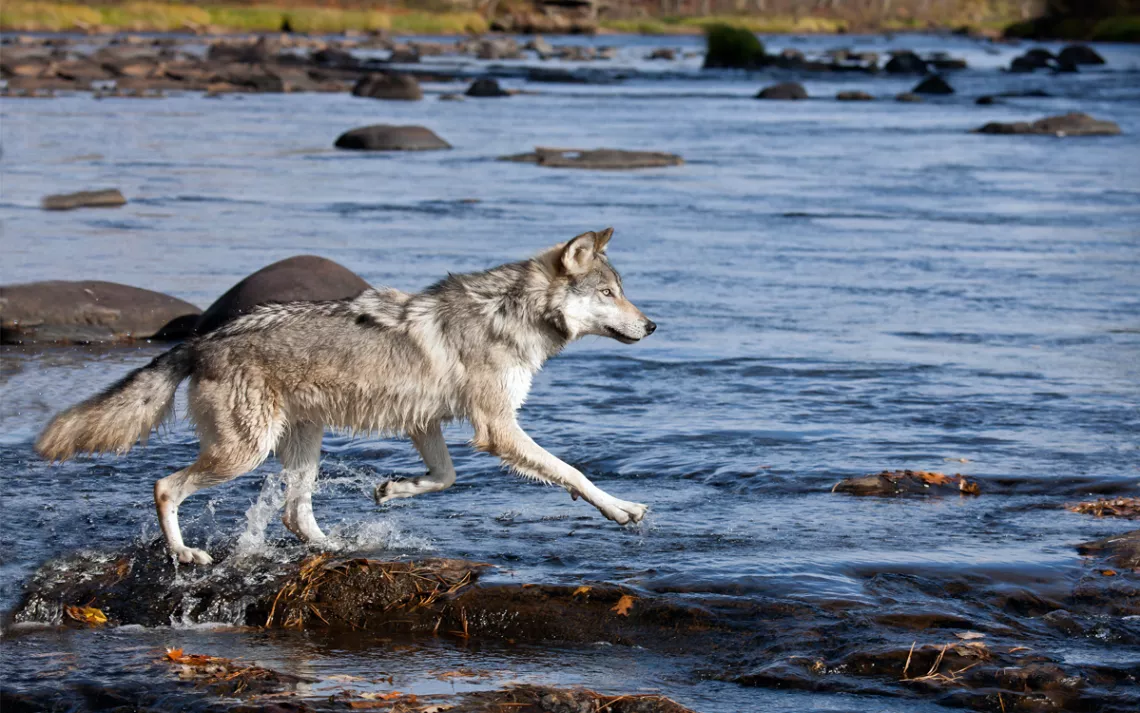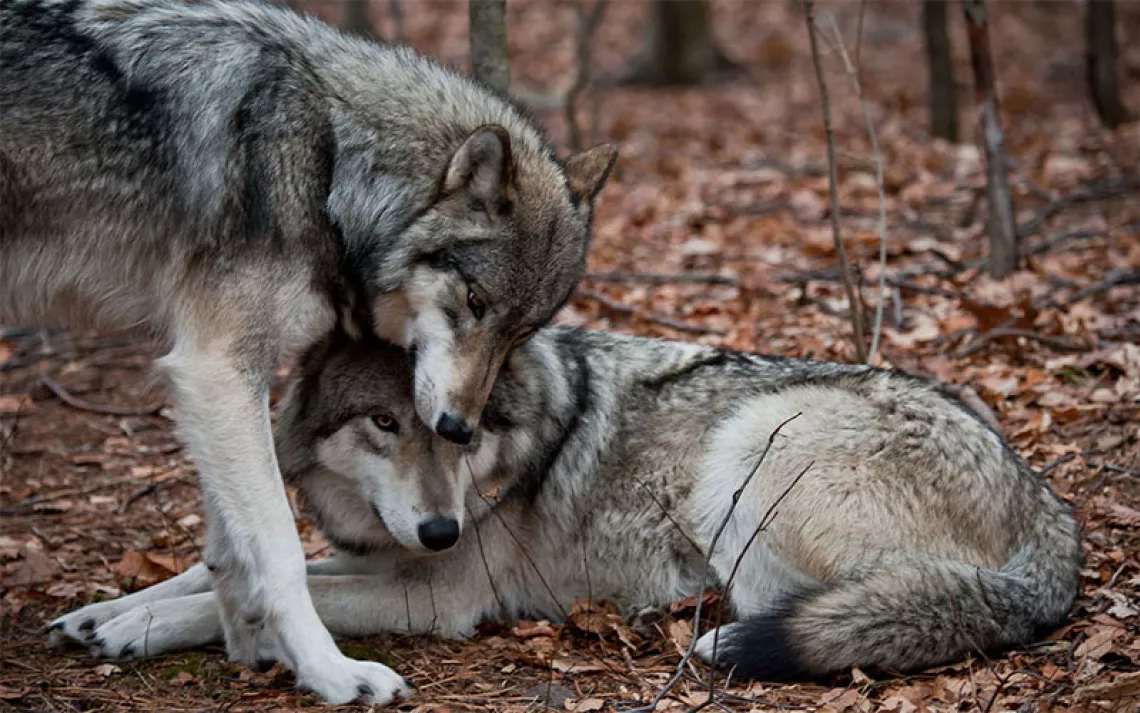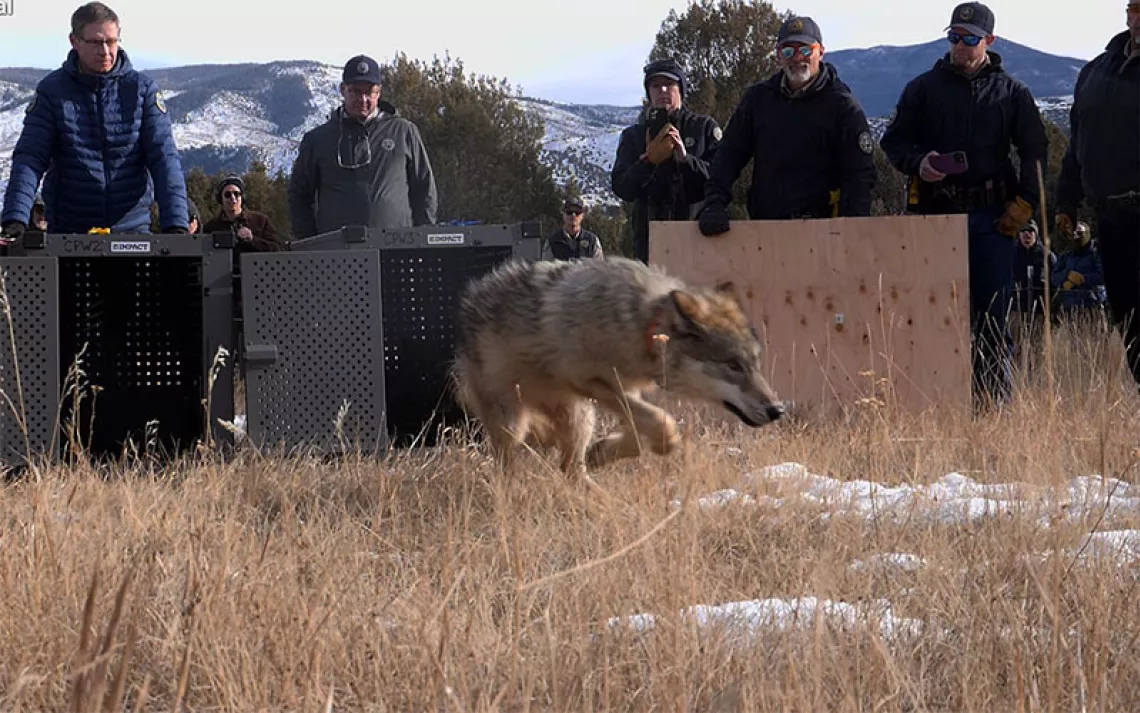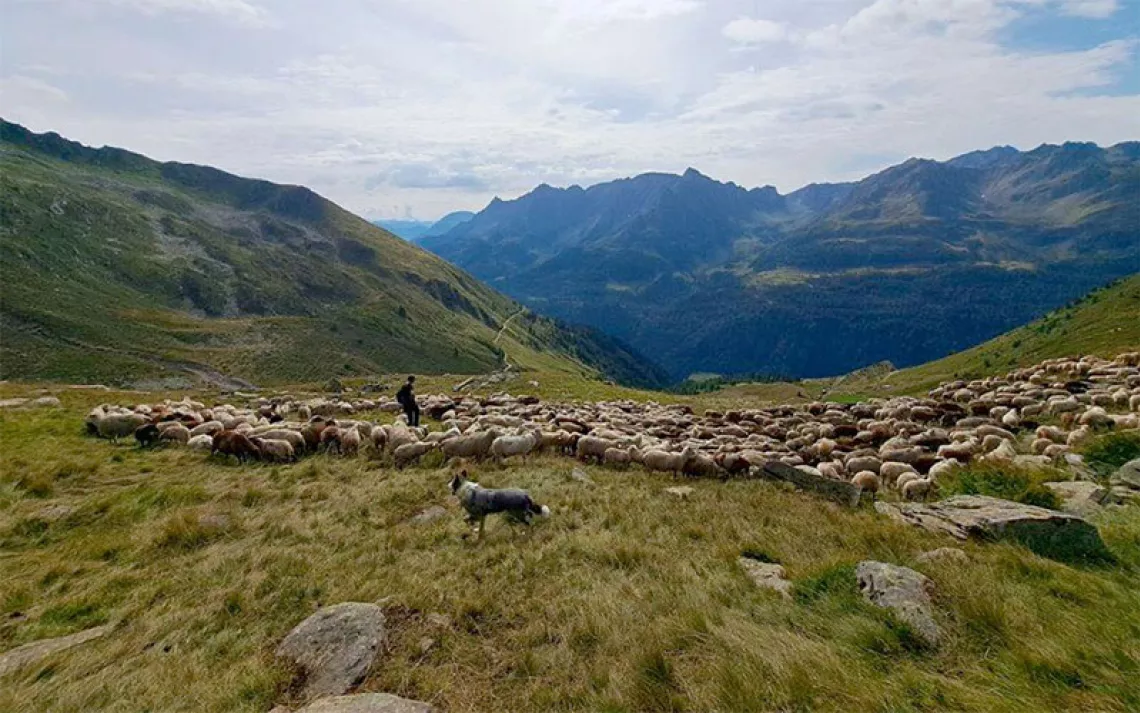Wolves Have Personalities That Impact Their Ecosystem
Some wolves are better at hunting beavers than others, leading to consequences far beyond the pack

Photo by Lynn Bystrom | iStock
A high-speed chase by a carefully coordinated pack might be the quintessential image of wolves catching their meal. But for some wolves in Minnesota's Voyageurs National Park and beyond, hunting can involve a long day alone, waiting to ambush their target. For biologists like Joseph Bump, seeing a wolf remain motionless for most of the day often means one thing: It’s beaver-hunting time.
Wolves need patience and persistence to ambush beavers, since the semiaquatic rodents are more likely to be swimming in a pond or using a densely vegetated trail than to be grazing in an open meadow. The novel predatory behavior was revealed by researchers at the Voyageurs Wolf Project, who recorded a wolf hunting and killing a beaver for the first time in 2015. Their research has revealed that beavers are a common prey choice for wolves, especially during warmer months. However, not all wolves possess the cunning it takes to score a tasty beaver meal.
A recent follow-up study has now uncovered that the ambushing behavior is an indication of individual personalities. These personal traits can even have an outsize impact on the species and ecosystems around them, concludes a new study from the Voyageurs Wolf Project. The findings were released in the June issue of Frontiers in Ecology and the Environment, a peer-reviewed scientific journal, and contribute to a growing body of research on animal personality.
Scientists have long recognized the intellectual capacity of animals, but this research into wolf behavior gives them a window into how personality influences the natural world. Since beavers are ecosystem engineers in their own right, removing them from the landscape through predation means that dams may be abandoned, especially dams of a single beaver. Once their watery abodes deteriorate, the composition of the forest changes.
“A successful ambushing character for wolves requires that they’re able to wait at these beaver ponds along feeding trails, and certain individuals wait much more often and much longer than others,” says Bump, a professor in the Department of Fisheries, Wildlife, and Conservation Biology at the University of Minnesota, who led the study.
Wolves that wait can score their beaver prey, while the less-patient wolves might sustain themselves with other food sources like deer, hare, and even berries, which many turn to during the summer. The project has also found that successful beaver-hunting wolves know to stay downwind of their prey but often wait in plain view, since beavers have poor eyesight but a strong sense of smell.
The wolves in the study wore GPS collars attached by biologists at the Voyageurs Wolf Project, which is primarily funded by the University of Minnesota and the Minnesota Environment and Natural Resources Trust Fund. Without this technology, it’s impossible for biologists to understand what wolves do during the summer, since the forest fills in with dense plants that prevent direct observation. The collars are designed to fall off after two or three years, but before that, the team receives valuable information about where the wolves go and how they spend their days.
In the personality study, the team combined GPS data and on-the-ground observations to learn when a wolf ambushed a beaver. When they observed a wolf remaining in the same spot for many hours, they knew it could be waiting for a chance to nab its prey. After the wolf moved on from the location, someone would go look for evidence to learn what had happened.
“You’re like a forensic unit out there,” says Thomas Gable, the project lead at the Voyageurs Wolf Project and a collaborator on the wolf personality research. He’s used to hunting for tiny pieces of evidence to help him understand what a wolf did in a certain area. “That might be a little fleck of bone, it might be a few little tufts of fur. But oftentimes, it's very subtle,” he explains.
Wolves also sometimes leave behind a beaver’s skull, jaw, or even castor glands, Bump explains. His best guess is that those bones are too strong for wolves to bite through and that they avoid the scent glands “because they taste bad," he says, adding, “They can almost surgically remove them.” These kinds of clues can show whether a wolf found a meal in a particular spot or it just stopped to rest.
With several years of data from 16 wolves, Bump and his team created eight pairs matched by age, family pack, and location. He found that while some pairs hunted similar numbers of beavers, other wolves killed double or triple the number of beavers as their pack mate did. Since the level of beaver-hunting varied widely for some pairs, even between similar wolves in the same location, factors such as age and beaver density were ruled out when looking at the behavioral difference. This means wolves’ personalities are the most likely cause of the disparity.
The increased understanding of wild animals’ personalities has implications beyond just changing the natural world. In the study, the researchers note that a greater understanding of individuals’ behavior has the potential to improve interactions between wolves and humans.
For example, if a wolf kills cattle and harms a ranching business, some might want to lethally remove the entire pack, says Bump. This research reveals that hunting traits can be unique based on individual wolves’ personalities, so wildlife managers could consider whether that extreme measure would be necessary. “But wolves are highly social, and pack members learn from one another,” Bump emphasizes, so each case will differ.
After decades of research on wolf populations, a next step is to better understand individuals, explains Joseph Hinton, senior research scientist at the Wolf Conservation Center. “It’s kind of like keystone individuals—some individuals are going to have a more profound effect on their local communities than some other individuals,” he says.
When wolves hunt beavers in Voyageurs National Park’s boreal forest ecosystem, they remove the wetlands those beavers maintain with their dams. Each year when young beavers disperse from their parents’ lodges, they create ponds in drier areas by building new dams. Without wolves getting involved, 84 percent of those wetlands remain for at least a year. But when a wolf kills the dispersing beaver, the pond will dry up, research from the project shows.
Hinton says the study on wolf personalities contributes to a body of research illustrating how specific predators can have a top-down effect on their ecosystems, known as a trophic cascade. A study in Alberta, Canada, identified a single grizzly bear that specialized in hunting mountain goats, while other grizzlies in the area were never observed to hunt goats. Another research team in Colorado found a mountain lion that preferred to hunt beavers, just like some Voyageurs National Park wolves.
The new finding about wolves’ personalities comes as no surprise to John Hoogland, a professor at the University of Maryland who studies prairie dogs. In his roughly 45 years studying the species, he’s observed that every animal has its own personality, and it’s often a matter of being in the right place at the right time to record their unique behaviors. “If I have 150 prairie dogs, I have 150 personalities,” he says.
His research team happened to encounter a strong predator personality at a prairie dog research station in New Mexico in 2018. In late spring, a badger mom with a unique hunting style moved into the prairie dog colony. She killed at least 100 prairie dogs in just over a month, decimating the local population.
“She was just an all-around very impressive and effective predator,” says Sam Kagel, the lead author of the study about the badger, which the team named Becky. Becky the badger likely killed even more than 100 prairie dogs, given that the team observed hunting only during the day, and badgers often hunt at night as well.
Like beavers, prairie dogs are a keystone species, Hoogland explains. The burrows they dig impact the circulation of water and minerals in their environment, and their tunnels serve as homes to species like ferrets, salamanders, turtles, and arachnids. “Many, many animals depend on them to one degree or another,” he says.
This means that a single badger’s strong hunting personality, just like a wolf's, can have an outsized impact on an ecosystem.
The heavy predation of a keystone species like beavers may seem concerning because their wetlands promote biodiversity. But it doesn’t seem to have a negative impact: “We don’t see drops in beaver density at the landscape scale even when we have these strong beaver hunting personalities,” Bump says.
In an ecosystem with a healthy beaver population like the Voyageurs National Park, young beavers regularly disperse and create new dams. So while a persistent wolf may reduce wetlands for at least a year by hunting beavers, new ones can come to replace them. Apparently, beavers have a persistent personality too.
 The Magazine of The Sierra Club
The Magazine of The Sierra Club



